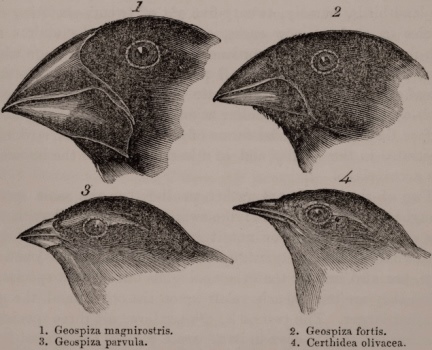Darwin’s Theory

(1809 - 1882)This photo was taken circa 1854. File source: Wikimedia commons, public domain.
Darwin’s key idea was that evolution is driven by natural selection—the natural elimination of hereditary traits (physical characteristics) that do not promote survival and reproduction, and the preservation of traits that do. Darwin coined the term “natural selection” to draw an analogy with artificial selection—the familiar practice of selective breeding. As everyone knew, you can breed two fast horses together to get an even faster horse; you breed two funny-looking dogs together to get an even funnier-looking dog, and so on. Darwin argued that a similar type of selection happens in the wild: nature “selects” the organisms best suited to survive and reproduce in a given habitat, and breeds them together to produce offspring that are even better suited, or adapted, to that environment.
To support this idea, Darwin presented numerous cases in which natural selection had apparently taken place. One of his most famous examples involved a variety of birds he had observed during a visit to the Galápagos Islands. (Darwin called the birds “finches,” though they weren’t true finches according to modern taxonomy.) In a published diary detailing what he had found on the islands, Darwin noted that several different species of birds were similar in most respects, except that their beaks were slightly different shapes and sizes. He suggested that a single species of birds had migrated to the islands in the past, and their offspring had evolved through natural selection to produce a variety of new species, each of which had adapted to eat a certain type of food present on the islands:

This illustration of the Galápagos “finches” appeared in Darwin’s published journal.The illustration was drawn by ornithologist John Gould, to whom Darwin had given numerous bird specimens for identification. It appears on page 379 of Darwin’s Journal of researches into the natural history and geology of the countries visited during the voyage of H.M.S. Beagle round the world, under the Command of Capt. Fitz Roy, R.N. 2d edition. London: John Murray. Available here. This image is in the public domain.
Seeing this gradation and diversity of structure in one small, intimately related group of birds, one might really fancy that from an original paucity of birds in this archipelago, one species had been taken and modified for different ends.Charles Darwin (1845), Journal of researches into the natural history and geology of the countries visited during the voyage of H.M.S. Beagle round the world, under the Command of Capt. Fitz Roy, R.N. 2d edition. London: John Murray, p. 380. Available here.
Perhaps long thin beaks were best-suited for picking berries; short strong beaks were better for cracking seeds. Birds with neither of those desirable traits might starve, or at best have trouble finding enough food to raise a family. Thus, natural selection would gradually eliminate any beak shapes not well-adapted for eating foods available on the islands. Over time, the birds would develop various types of specialized beaks, corresponding to different types of foods. Through processes like these, one species could diversify to become separate species. This process of diversification, or “branching out” (so to speak) from a common ancestor, is called adaptive radiation.
There was a fundamental problem with Darwin’s theory, however. Natural selection by itself doesn’t explain how adaptive radiation occurs. It may explain why birds with certain traits (e.g. shorter beaks) flourish in some habitats and die off in others, but natural selection doesn’t explain how new traits are introduced in the first place. This is clearly evident in an oft-cited case of natural selection, which took place in the wake of the industrial revolution:

The outline of this peppered moth is barely visible against the light bark of an unpolluted tree.
Then the industrial revolution happened. The trees were blanketed with dark coatings of soot from nearby coal-burning factories. The light-colored moths were readily devoured by their avian predators. In the span of a few years, however, a previously uncommon variety of peppered moth—one with a much darker hue—quickly proliferated.
Although natural selection explains why the darker moths increased in number (while the lighter moths were decimated), it doesn’t even begin to explain where the two varieties of peppered moth came from in the first place. In fact, both light and dark varieties had been documented to exist prior to the industrial revolution. (And both still exist today. In fact, the light-colored variety has made a comeback, thanks to a reduction in industrial pollution.)
Like his predecessors, Darwin failed to identify the mechanisms responsible for producing new traits. To be fair, he did offer hypotheses about the production of new traits, but that aspect of his theory was soon discarded as a new field of study began to emerge: the science of genetics. Modern evolutionary biology relies on genetic theory to explain how new varieties of life emerge. As we’ll see in what follows, the theory of evolution itself has evolved quite a bit since its inception in the 18th and 19th centuries.